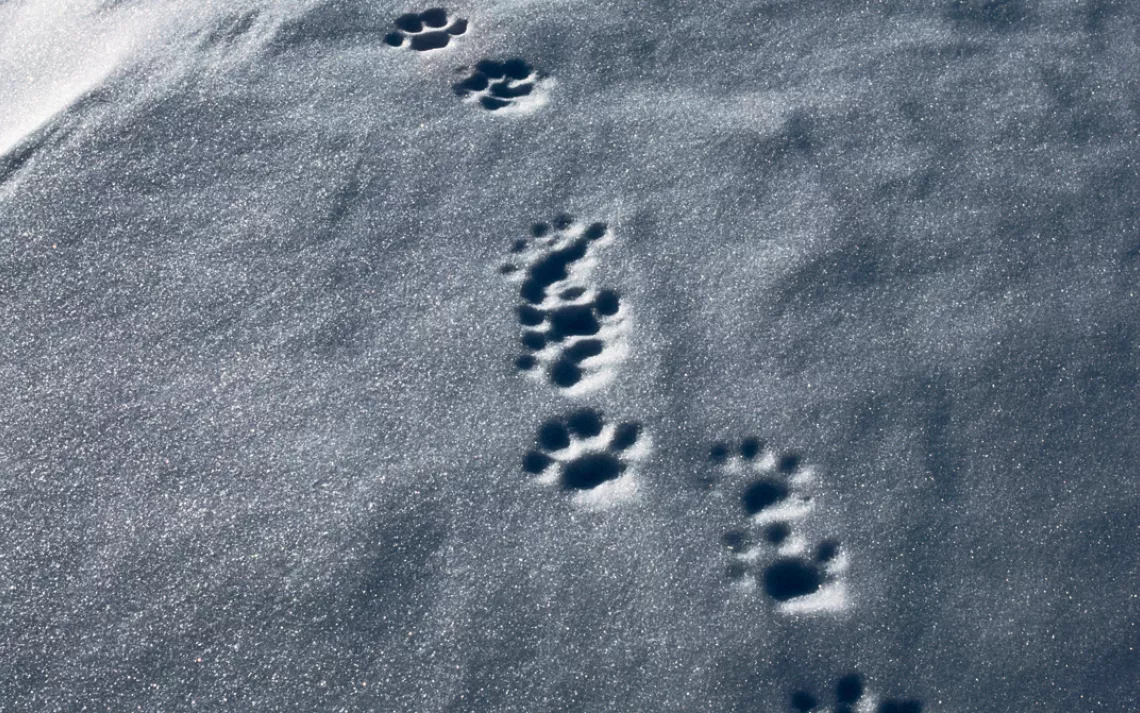Written in Snow: Learning How to Track Wild Animals
Citizen scientists forgo the slopes to search for scat

After 12 days of bluebird skies and not a speck of new snow, winter finally returns to the Northern Rockies. Powder clauses are enacted, meetings canceled—it's time to get to the mountains.
But instead of slapping on skins and heading for the hills, I gather with 20 other Capilene-clad skiers inside a classroom in West Yellowstone, with nary a ski slope in sight. We're passing up one of the most celebrated powder days of the season to watch slideshows and hear about poop. We've signed up to spend the morning learning about tracking rare carnivores like lynx, wolverines, and fishers and how to collect samples of their DNA. A scoop of scat ranks as the gold standard. "Air-dry it. Don't put it in your oven," cautions one of the instructors. I can feel it: I'm on my way to becoming CSI's next forensic expert.
These small mammals travel large distances over difficult terrain, making them notoriously hard to track. And in an era when funding for land management agencies is shrinking, fewer boots are on the ground to collect data. That's where our group of citizen scientists comes in. We can report animal sightings, log tracks on GPS devices, and harvest hair or scat for DNA. I feel a twinge of excitement thinking that maybe, just maybe, I'll spot the critical fisher that will tip a conservation debate in the right direction.
Outside our classroom, snow falls in a steady curtain. Inside, our instructor points to a slide of a wolverine and describes how they can sniff out years-old buried bones. Next he explains that lynx love to walk across logs and that critical lynx habitat often overlaps with prescribed burn areas, presenting a tricky predicament for land managers. By the time we get to the fisher, one of the porcupine's only predators, I've forgotten about the turns I'm missing.
After lunch we bundle up and head out for a meander through a large grove of lodgepole pines. Despite the falling snow, there are plenty of crescents, dots, and dashes to decode. The signs aren't as simple as the pocket guides would have you think. It's an entire language to learn, with various strides to decipher—a single species can pace, bound, or gallop—and buried evidence to discover. Old beds iced over by a hard-melt freeze are gold mines for strands of stray hair.
I walk for a bit, then kneel to draw my hands around the compacted plug of a print and pull it out, a snow mold of an animal's foot. Its depth betrays the creature's weight. A fox.
By day's end, my mind is on overdrive with all the new information. It reminds me of the first avalanche course I ever took, when my eyes were suddenly opened to the language of the land I'd skied through for years. But learning about avalanches was also overwhelming. How would I ever remember the difference between what surface hoar and diurnal recrystallization looked like, I wondered?
Over the years, snow crystal patterns, the different uses of snow stability tests, and the lists of hazardous conditions have slowly worked their way into my brain. They make sense now. But as I stand ready to read a different language in the snow, I lament that my education has been so narrow.
I'd bet my new ultralight, rocker skis that most backcountry travelers can't identify much beyond the tracks of a snowshoe hare. And why should they? Recognizing the long, deep toe drag of a red squirrel no longer has any bearing on our survival. But picking out a layer of submerged surface hoar in the snowpack does. It's the difference between getting buried and skiing home to a cup of cocoa.
I'm not advocating a return to wolverine hide coats and lynx meat burgers. But what if we decide that these animals are once again critical to our survival? Not in the sense of consumption, but critical to the survival of our souls.
As I drive home that evening, my wipers snap across the windshield, fighting to stay ahead of the flakes. Stuck in a similarly frenetic beat, my thoughts jump between the promise of virgin turns and the mysterious messages waiting to be written on the canvas falling before my eyes.
 The Magazine of The Sierra Club
The Magazine of The Sierra Club



